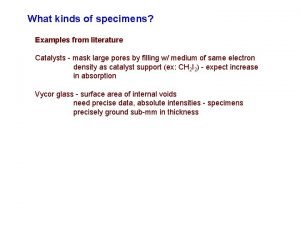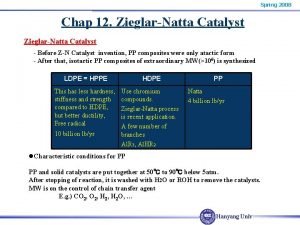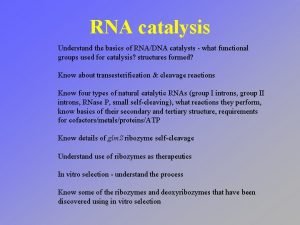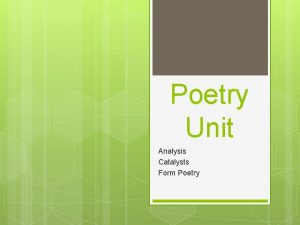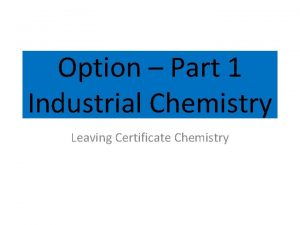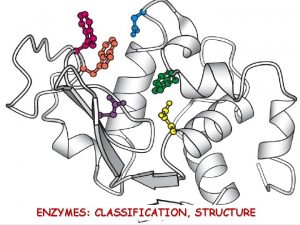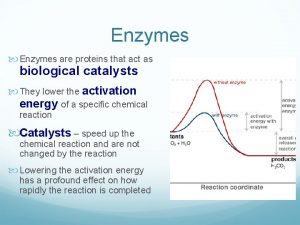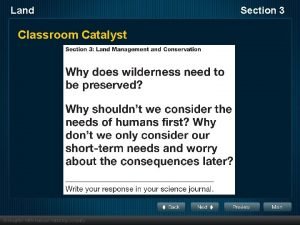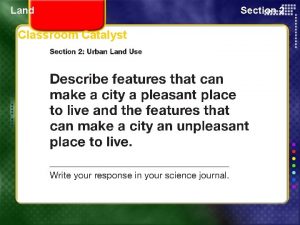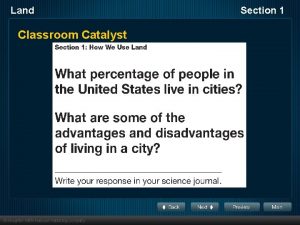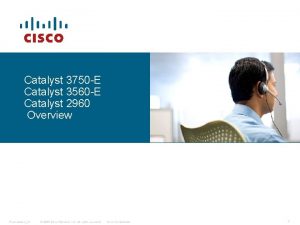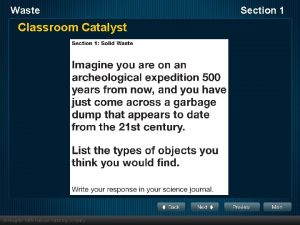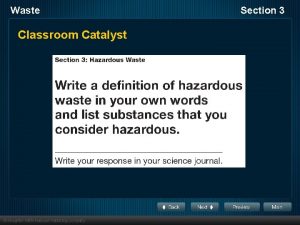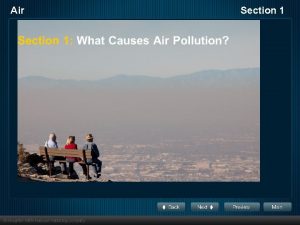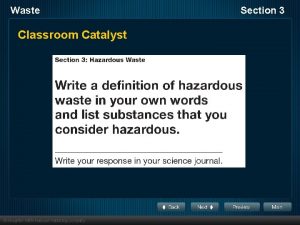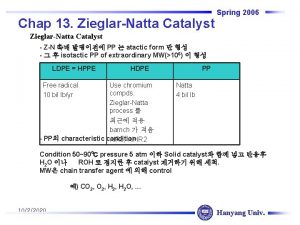Land Classroom Catalyst Section 1 Land Section 1












- Slides: 12

Land Classroom Catalyst Section 1

Land Section 1 www. citylab. com/housing/2012/03/us-urbanpopulation-what. . . /1589/ According to new numbers just released from the U. S. Census Bureau, 80. 7 percent of the U. S. population lived in urban areas as of the 2010 Census, a boost from the 79 percent counted in 2000.

Land Section 1 Objectives • Distinguish between urban and rural land. • Describe three major ways in which humans use land. • Explain the concept of ecosystem services.

Land Section 1 Land Use and Land Cover • We use land for many purposes, including farming, mining, building cities and highways, and recreation. • Land cover is what you find on a patch of land, and it often depends on how the land is used. For example, land cover might be a forest, a field of grain, or a parking lot. • There are different types of land cover and different human uses for each cover type.

Land Use and Land Cover Section 1

Land Section 1 Land Use and Land Cover • Urban describes an area that contains a city, or an area that contains 2, 500 or more people and usually has a governing body, such as a city council. • Rural describes an area of open land that is often used for farming, or any population not classified as urban. • Most land provides one or more resources that humans consume. These resources include wood in forests, crops in farmland, and mineral resources.

Land Section 1 Where We Live • Until about 1850, most people lived in rural areas. • Many of them were farmers, who grew crops and raised livestock. Others managed the forests, worked in local mines or mills, or manufactured the necessities of life for the town. • The Industrial Revolution changed this pattern as machinery made it possible for fewer people to operate a farm or grain mill and better transportation allowed manufacturers to be located farther from their customers.

Land Section 1 Where We Live • Thousands of rural jobs were eliminated, and many people had to move to cities to find jobs. • As a result, urban areas grew rapidly during the 20 th century and spread over more land. • The movement of people from rural to urban areas happened in developed countries between about 1880 and 1950. Now, this movement is occurring rapidly in developing countries.

Land Section 1 Where We Live • Today, most people throughout the world live in urban areas.

Land Section 1 The Urban-Rural Connection • Whether people live in cities or in the countryside, people are dependent on resources produced in rural areas. • These resources include clean drinking water, fertile soil and land for crops, trees for wood and paper, and much of the oxygen we breath, which is produced by plants. • An ecosystem service is the role that organisms play in creating a healthful environment for humans.

Land The Urban-Rural Connection Section 1

Land Section 1 Supporting Urban Areas • The area of rural land needed to support one person depends on many factors, such as the climate, the standard of living, and how efficiently resources are used. • Each person in a developed country uses the ecosystem services provided by about 8 hectares of land. But, many people in developing countries do not have access to all the resources for a healthy life, and may use ecosystem services from less than a hectare of land person.
 Sourima mal
Sourima mal What are landforms
What are landforms High rocky land usually with steep sides
High rocky land usually with steep sides Xxxx websites
Xxxx websites Catalyst in literature
Catalyst in literature Wintergirls chapter summary
Wintergirls chapter summary Ziegler natta catalyst
Ziegler natta catalyst Rna catalyst
Rna catalyst Acrostic poem about the importance of catalyst
Acrostic poem about the importance of catalyst Finely divided catalyst
Finely divided catalyst What's a biological catalyst
What's a biological catalyst Classification of coenzyme
Classification of coenzyme Protein that acts as biological catalyst
Protein that acts as biological catalyst




